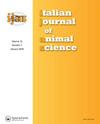豇豆蛋白水解物在肉鸡饲粮中的潜在应用:对生长、肠道形态、肌肉脂质和免疫状态的影响
IF 2.3
3区 农林科学
Q1 AGRICULTURE, DAIRY & ANIMAL SCIENCE
引用次数: 0
摘要
本试验旨在研究饲粮中添加豇豆水解蛋白(CPH)对肉鸡生长、胴体性状、肠道组织形态学、胸肌脂肪酸谱、血液生化指标和免疫状态的影响。选取3日龄雄性Ross-308肉鸡300只,平均体重86.72 g±0.20 g,随机分为5组,分别饲喂5种CPH水平为0、2、4、6和8 g kg−1的饲粮,试验期35 d。结果表明:育肥期饲粮CPH对肉鸡的生长性能和胴体性状无显著影响(P < 0.05),但在2和4 g kg−1浓度下,肉鸡的FCR呈二次型降低(P < 0.05);十二指肠和空肠绒毛高度(VH)和杯状细胞计数(GCC)显著升高(P < 0.05);十二指肠绒毛宽度减小(P < 0.05),空肠和回肠绒毛宽度无明显变化(P < 0.05)。饲粮中添加6 g CPH kg−1增加了十二指肠隐窝深度(CD) (P < 0.05)。与对照组相比,饲粮中添加8 g CPH kg - 1可提高十二指肠VH: CD;然而,空肠出现二次型变化(P < 0.05)。回肠VH: CD无明显变化(P < 0.05);饲粮中添加6 CPH kg - 1可提高回肠VH和GCC (P < 0.05)。CPH的添加导致肉仔鸡胸肌中总n-3多不饱和脂肪酸(PUFA)、n-6多不饱和脂肪酸和n-3/n-6多不饱和脂肪酸呈线性增加(P < 0.05)。血清中甲状腺激素、生长激素、总蛋白、白蛋白、球蛋白、溶菌酶、干扰素- γ、白介素10和补体3水平均升高(P < 0.05)。血清葡萄糖和瘦素水平对饲粮CPH无显著影响(p > 0.05)。此外,饲粮CPH水平4 ~ 8 g kg−1上调了各组脾脏IgG的免疫染色。上述结果提示,在肉鸡饲粮中添加CPH可能是调节鸡代谢和免疫状态的有效候选物;但对肉鸡生长无促进作用。本文章由计算机程序翻译,如有差异,请以英文原文为准。
Potential use of cowpea protein hydrolysate as a dietary supplement in broiler chickens: effects on growth, intestinal morphology, muscle lipid profile, and immune status
In the current study, we tested the effects of dietary cowpea protein hydrolysate (CPH) on broilers’ growth, carcase traits, intestinal histomorphology, The fatty acid profile of breast muscle, blood biochemical parameters, and immune status. Three-day age male Ross-308 broilers (n = 300, average weight 86.72 g ± 0.20) were distributed into five groups and fed on five diets supplied with five levels of CPH at 0, 2, 4, 6, and 8 g kg−1 for 35 days. The results revealed that dietary CPH did not change (P < 0.05) the broilers’ growth performance or carcase traits, except for a quadratic decrease (P < 0.05) in FCR at concentrations 2 and 4 g kg−1 during the finisher period. The villus heights (VH) and goblet cell count (GCC) were increased (P < 0.05) in the duodenum and jejunum; however, the villus width decreased (P < 0.05) in the duodenum without showing changes (P < 0.05) in the jejunum and ileum. Dietary supplementation with 6 g CPH kg−1 increased (P < 0.05) the duodenal crypt depth (CD). Dietary supplementation with 8 g CPH kg −1 increased the VH: CD in the duodenum compared to the control; nevertheless, a quadratic (P < 0.05) change was reported in the jejunum. The VH: CD did not change (P < 0.05) in the ileum; however, dietary supplementation with 6 CPH kg−1 increased (P < 0.05) the ileal VH and GCC. The inclusion of CPH led to a linear (P < 0.05) increase in the total n-3 polyunsaturated fatty acids (PUFA), n-6 PUFA, and n-3/n-6 PUFA in broilers’ breast muscle. An increase in the assessed metabolic and immune status indices was reported, as evidenced by increases (P < 0.05) in thyroid hormones, growth hormone, total protein, albumin, globulin, lysozymes, interferon-gamma, interleukin10, and complement 3 serum levels. However, the serum glucose and leptin levels did not show significant (p > 0.05) changes in response to dietary CPH. Moreover, the dietary CPH levels 4–8 g kg−1 upregulated the immunostaining of IgG in the spleen of these groups. These findings suggested that including CPH in broiler diets could be an effective candidate for modulating the chickens’ metabolic and immune status; however, it had no increased effect on broiler growth.
求助全文
通过发布文献求助,成功后即可免费获取论文全文。
去求助
来源期刊

Italian Journal of Animal Science
农林科学-奶制品与动物科学
CiteScore
4.90
自引率
8.00%
发文量
141
审稿时长
18-36 weeks
期刊介绍:
The Italian Journal of Animal Science is an international peer-reviewed open access journal publishing original scientific papers, reviews and short communications on animal science, animal production and related areas. The journal welcomes submissions on the following subjects:
• Animal derived food quality and safety
• Animal genetics and breeding
• Aquaculture, poultry, companion and wildlife
• Livestock systems, management and environment
• Non-ruminants nutrition and feeding
• Production physiology and biology
• Ruminants nutrition and feeding
Announcements of congresses, presentations of universities, research institutes, books and proceedings may also be published, as well as news regarding the members of the Animal Science and Production Association (ASPA). The Association will be glad to receive proposals for your admission as an ordinary or corresponding member: please read regulations and procedures in the statute of the ASPA .
 求助内容:
求助内容: 应助结果提醒方式:
应助结果提醒方式:


